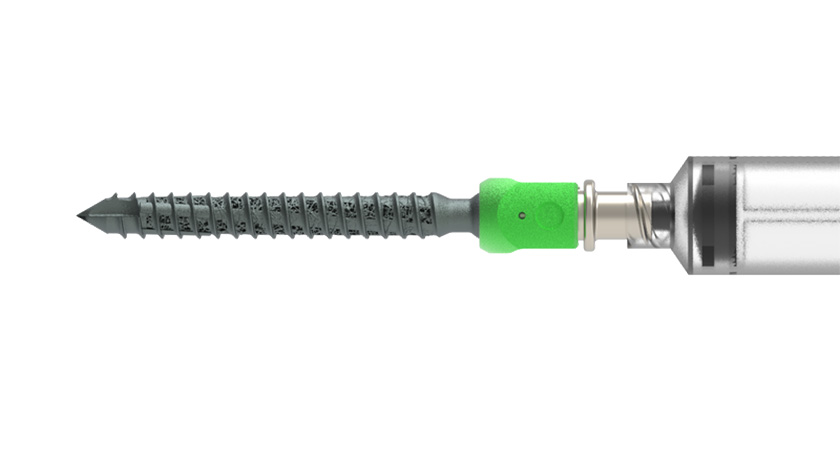
The emergence of regenerative therapies has sparked a new era in orthopedic care. Orthobiologics that regenerate cartilage present a promising option for surgeons who want to help patients remain active without resorting to more invasive approaches. The emergence of chemically engineered implants is also addressing cartilage degeneration in joints throughout the body, providing another avenue for treating chronic pain and keeping patients moving.
These forthcoming therapies leverage the regenerative capabilities of the human body to not only accelerate the healing process but also create possibilities for first-line treatments of joint injuries and chondral defects that rob patients of their quality of life. It’s an area of orthopedics that’s generating a great deal of excitement as it continues to evolve.
The Power of Natural Healing
As the field of regenerative medicine pushes the boundaries of what’s possible, groundbreaking therapies are addressing injuries in the knee, shoulder and elbow, according to Nina Tandon, Ph.D., EpiBone CEO and Co-Founder.
“Regenerative medicine focuses on amplifying the body’s natural processes and leveraging its inherent healing capabilities,” Dr. Tandon said. “As it currently exists, the field involves stem cell treatments, injections and platelet-rich plasma (PRP) therapies. Future innovations will include treatments similar to what we’re doing with tissue engineering.”
Tissue engineering takes the idea of regenerative medicine a step further by differentiating stem cells to grow into specific tissues before implantation, Dr. Tandon explained. She pointed to EpiBone’s pioneering process in guiding stem cells to create tissue before implantation — an approach that was previously hindered by a lack of methods and knowledge.
EpiBone’s three-step process uses a CT scan to determine the exact three-dimensional size and shape of bone or tissue needed for a patient. Stem cells are also extracted from the patient’s abdominal fat. Next, EpiBone creates a precise, personalized model of the needed bone or tissue. A bioreactor, designed to mimic the conditions of the human body, is then used to encourage the stem cells to multiply and start building bone or cartilage.
A scaffold is used in this carefully crafted environment to guide the stem cells to remodel into a personalized bone or cartilage tissue graft that is ready for implantation. Once implanted, the new graft has the potential to mature and integrate with surrounding tissues.
“The process takes roughly three weeks to engineer bone and four weeks to engineer cartilage,” Dr. Tandon said.
Instead of borrowing tissue from one part of a patient’s body to benefit another — like using a hamstring tendon to replace an ACL — EpiBone’s approach encourages long-term outcomes without the need for a secondary surgical site. These grafts could also offer an alternative for osteochondral allografts, which are donor plugs of cartilage taken from cadavers. While effective, they are in short supply. By cultivating grafts in a lab, EpiBone is also eliminating risks of disease transmission and donor matching issues.
Dr. Tandon noted that regenerative medicine is falling in line with the latest trends in tailoring treatments to individual patients. Cartilage is an immune-privileged tissue, meaning EpiBone can provide a more convenient, off-the-shelf solution by using donor stem cells. For bone, the approach involves using the patient’s cells to achieve a perfect anatomical shape and immune-matching properties.
EpiBone has received Investigational New Drug (IND) clearance from FDA to begin testing its lab-grown knee cartilage in humans. Clinical trials will evaluate the safety and efficacy of EpiBone’s graft compared to current treatments. Patient recruitment is set to begin in early 2024.
Dr. Tandon noted that EpiBone is also exploring possibilities with the Department of Defense to engage in studies for highly active individuals who would emphasize the need for personal patient care. “We could take into account genetics and injury-specific issues,” she said. “All factors that are individual to a patient could eventually be utilized and addressed in tailored treatments.”
A Shift in Osteoarthritis Management
As orthobiologics continue to gain momentum, the spotlight has intensified on their role in managing osteoarthritis, the chronic condition that has long posed significant challenges to patients and healthcare providers. While the promise of the technology is evident, questions linger about the full extent of tissue treatments in the complex landscape of osteoarthritis.
Sparta Biomedical has introduced Galene, its biomimetic cartilage platform. Unlike traditional regenerative medicine approaches, Galene offers a unique solution to the debilitating effects of knee osteoarthritis, providing immediate pain relief and enabling patients to reclaim their lives.
“This is the first-of-its-kind cartilage-mimicking platform that’s adhered to a titanium base,” said Dushyanth Surakanti, Sparta Biomedical’s CEO and Founder. “The cartilage-like substance mimics properties of native cartilage. This allows for immediate, painless weight bearing in patients, as opposed to a six-to 12-month recovery.”
Galene’s success lies in its ability to mimic the properties of native cartilage. The porous titanium base allows for bony ingrowth, ensuring long-term fixation. The compressive and shear force properties of Galene closely match those of natural cartilage, protecting the joint during various movements.
“It’s not just about withstanding moving up and down, but also the physiological loads that are placed on the knee during movement,” Surakanti said. “Moving side to side or even bending down induces stress and strain that’s altogether different from just walking. We need to make sure that the cartilage-like implant responds appropriately during those movements.”
Galene offers a cost-effective alternative to biologics, Surakanti said. He noted that current treatment approaches, such as harvesting tissue from cadavers or 3D printing personalized implants, are often challenging to scale or prohibitively expensive. Galene’s standardized approach and multiple size options enable immediate availability and make the procedure economically viable for a wide range of patients.
Surakanti noted that Galene targets a diverse patient population, including those with a BMI over 35, aiming to provide a solution for both active individuals and those affected by the toll of aging on their knees. “I think most patients would buy into regenerating their own tissue to recreate cartilage they’ve lost,” he said. “We believe the approach has a lot of merit, but it’s been pursued for several years and has historically struggled to demonstrate great outcomes. This device can meet the needs of a lot of patients now.”
The Galene platform’s first application is in the company’s Ormi implant, a cartilage-mimicking device adhered to a titanium base that is inserted into the knee to replace defective cartilage. The Ormi device received Breakthrough Device Designation by FDA in 2021. This September, Sparta Biomedical received funding to accelerate preparations for the Investigational Device Exemption study, which is scheduled to begin in early 2024.
Ormi is ideal for patients with moderate osteoarthritis. The target demographic is individuals who are not yet in need of a total knee replacement or those who are young enough to not want to go through a total knee replacement and will likely require a second one in their lifetimes.
Surakanti likens the simplicity and effectiveness of the procedure to getting a cavity filled, with the surgeon efficiently placing the device into the defect area in under 10 minutes.
The Ormi platform comes with a custom instrumentation kit to facilitate efficient placement of the device into the defect area. The device, which looks like a thumbtack, can be placed during an outpatient procedure in 30 to 45 minutes.
Surakanti noted that patients, although they experience some pain from the surgical incision, are expected to ambulate without the aid of crutches almost immediately after the procedure. “In a matter of days, they will be back to walking without a limp and starting additional physical activity,” he said.
Navigating the Unknown
While optimism abounds concerning cartilage repair and regeneration, the road ahead for these new technologies is not without challenges. Questions about the full spectrum of their potential and precise role in osteoarthritis treatment persist. However, with continued research, collaboration between experts and advancements in technology, the answers will unfold, unlocking new possibilities for improved patient care.
Sparta Biomedical has plans to expand its portfolio beyond knee applications. The team envisions using the Galene platform in the toe, thumb, hip, shoulder and eventually for total joint replacements. While acknowledging the potential of regenerative medicine, Surakanti emphasized the immediate cost-effective impact that Galene provides, positioning it as a viable and accessible solution in the evolving landscape of orthopedic treatments.
“We’re solving a biological problem through the intersection of engineering, chemistry and biological materials science,” Surakanti said. “There have been many failures in regenerative medicine — it’s a tough nut to crack — and quite honestly, our view is that patients shouldn’t have to wait for the care they need. They should get the relief they need now.”
When discussing the barriers and challenges in the field, Dr. Tandon identified three horizons of growth: ensuring the technology works in living systems, transitioning into clinical efficacy and demonstrating cost benefits for reimbursement coverage. Addressing concerns from end-users, surgeons, payers and regulatory bodies requires a multi-stakeholder approach and a focus on clinical trial data that shows a cost-benefit and potential long-term savings for the healthcare system.
Dr. Tandon emphasized the importance of treating patients as partners, ensuring clinical trials are representative of the ultimate end-users, and providing broad access to cutting-edge therapies.
She believes regenerative medicine treatments will become cost-effective in the long run and said the focus on value-based care could justify the higher upfront costs of the therapies through sustained benefits over time.
“Regenerative medicine might cost more upfront, but we believe it will cost less overall in terms of the need for surgery and hospital stays,” Dr. Tandon said.
She envisions a future in which regenerative medicine becomes a “one-stop body shop” for proactive joint care, eliminating the need for traditional surgery to replace diseased tissue and bone with metal implants. She added that universal donor stem cells and 3D bioprinting are expected to enhance the regenerative medicine landscape and test the boundaries of what’s achievable in the field.
“Regenerative technologies will dovetail with innovations in orthopedic care and manufacturing technology to push patient care forward,” Dr. Tandon said.
KK
Kendal Kloiber is a contributing editor.




